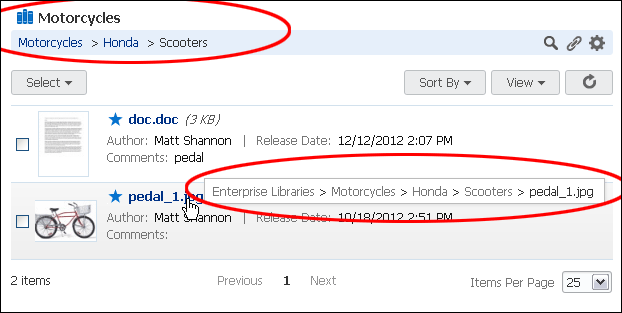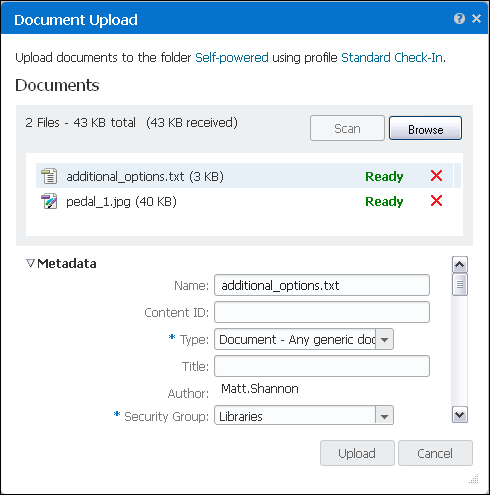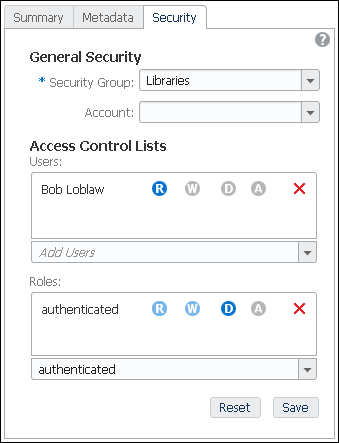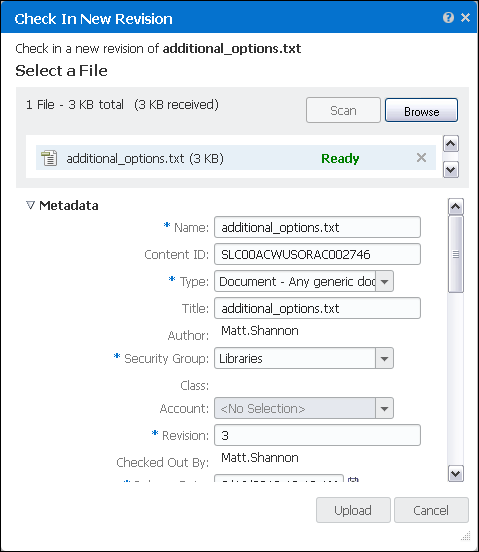How Can I View Documents That I Have Uploaded
17/35
xi Uploading and Checking In Documents
This chapter describes how to upload ane or more documents to Oracle WebCenter Content so they can be secured, viewed, and shared with others. It has the following sections.
-
Section 11.1, "Almost Uploading and Checking In Documents"
-
Section 11.2, "Uploading Documents from a Spider web Browser"
-
Section xi.three, "Checking In New Revisions from a Spider web Browser"
-
Section xi.4, "Uploading and Checking In Documents from WebCenter Content: Desktop"
-
Department eleven.five, "Uploading and Checking In Documents from a Mobile Device"
xi.1 Near Uploading and Checking In Documents
Yous upload a document to have it managed by Oracle WebCenter Content. Uploading a document copies the document into a repository and if WebCenter Content is set to practice so, converts the document to a version viewable in a web browser. Once the document is in a repository, it can be checked out, revised, and checked dorsum in. Oracle WebCenter Content controls access to the document, tracks revisions to the certificate, and maintains metadata data associated with the document.
When you upload documents to a specific library or binder, y'all must navigate to the library kickoff and and so upload the document. Doing so applies the correct metadata to a document and organizes it in Oracle WebCenter Content and so that y'all and others tin notice it. For detailed data on Libraries and Folders, see Chapter 5 and Chapter 6.
Effigy 11-i Document Context

11.2 Uploading Documents from a Spider web Browser
Uploading documents to Oracle WebCenter Content is similar to uploading documents in many other applications. In one case you lot begin, you navigate to the file you want to upload and then provide information about the document.
The information asked for when uploading a document is determined by the profile used when uploading. Profiles are configured by a system administrator to organize what metadata fields are available. For example, uploading a presentation using a contour configured for Marketing may require different metadata fields than when uploading a job awarding for Human Resources.
Much of the necessary information is automatically assigned based on the context of the library or folder used when uploading the document. For example, security access to a library automatically gets practical to a document uploaded to that library. If uploading to a folder in the library and the folder has different security properties, and so they override the library security properties. If you want, you tin can encounter and change the metadata data when uploading a document.
You lot begin uploading documents in one of the following means:
-
Select a contour from the Upload carte du jour on the Detect Documents folio. This option uses the metadata fields of the selected profile and the default information from the library or folder context used when uploading.
-
Select Upload Similar Document from the More bill of fare on either the Find Documents or View Documents page, or from the contextual menu when you correct-click a document on a results list. This selection uses the contour and default information of a document already uploaded to Oracle WebCenter Content.
Annotation:
When uploading a document, it is recommended that y'all navigate to the library or folder you want the document in and select the default profile used by the library or folder to ensure that all metadata options are available during upload. The default contour for a library or folder is listed in bold face at the height of the Upload menu.
Note that profiles can set default values for some metadata fields, but the library or folder used to upload the certificate tin override the profile.
To upload documents:
-
Select a profile from the Upload menu on the Find Documents page, or select Upload Similar Document from the More menu or a contextual menu. The Document Upload page is displayed.
Note:
The More menu is available on the Detect Documents page when a single document is selected and is also bachelor on the View Documents page.
-
Add one or more than files to the documents section of the Document Upload folio. You tin add together files in one of three means:
-
Drag-and-driblet one or more files from your file organisation to the documents department. Note that not all browsers support the ability to drag-and-drib.
-
Click Scan and navigate your file organisation to the file or files you want to add together.
-
Click Scan and add together files from a scanner.
Note:
The Scan push button is displayed when you select Enable upload by scanning from the user Preferences window. Yous must too have a TWAIN-compliant scanner properly connected to your workstation to apply this selection. For detailed information about the options available in the scanning application, click the Assist icon in the scanning application to see the online help system.
To remove a file from the list of documents, click the X adjacent to the file.
-
-
Expand the Metadata department to review and edit any data for the document that you want to change. Metadata options are available but if at least one file is added to the documents department. If multiple documents are added, the displayed metadata is for the selected document.
Note:
Metadata options are dependent on the profile selected. Default values are provided by the profile likewise equally the library and folder context. Some data is required as noted by an asterisk (*).
Do not change the selected contour on the Document Upload Metadata form. If you need to apply a dissimilar profile, cancel the upload and select the correct contour from the upload menu to begin again.
The Name field must be unique in the library or binder context being used or the upload fails. If the Name field is non available as a metadata option in the Document Upload course, then the file name of the file existence uploaded must be unique in the library or folder context.
When uploading multiple files there is an option to copy a given metadata value to all files being uploaded. For case, you lot can enter Status Report in the proper noun field and copy it to 12 other condition reports to exist uploaded, and then add the month to the proper noun value for each study separately: Status Written report - Jan, -Feb, -Mar, etc. Nevertheless, as the Proper name field value must be unique, you must make certain to change each value or the upload procedure will fail.
-
Click Upload.
Figure 11-ii The Document Upload Page

11.ii.i Changing Admission to Uploaded Documents
Access to documents uploaded to Oracle WebCenter Content is initially determined past the profile used to upload the document and the document context. This means that the library or folder to which the document is uploaded can set the default security metadata values. For example, if you upload a certificate to an enterprise library folder accessible by everyone without irresolute security settings, then everyone initially has access to the document.
You can change the access to unfiled documents or documents uploaded to an enterprise library using security groups, accounts, and access control lists. Table 11-1 lists and describes the security options available when uploading an unfiled document, or adding a document to an enterprise library in Oracle WebCenter Content.
Tabular array 11-i Security Options For Unfiled Documents and Enterprise Libraries
| Selection | Description |
|---|---|
| security groups | Security groups control admission to documents. Roles assigned to people within the security group are used to grant permissions to view, edit, and delete particular documents. The security grouping is a required metadata field for all documents and may exist assigned by default. Only those who belong to that security group can work with the document. When yous upload a file, you may be able to specify or change the security group metadata value. |
| accounts | Accounts are an optional feature that a organization ambassador can set up to define a more flexible security model. As with security groups, but users who have permission to a particular account tin can piece of work with documents that belong to that account. When you lot upload a file, you may be able to specify or change the account metadata values. |
| permissions | Each role tin have the following permissions for each security grouping:
The permissions for a security group are the highest permission defined by any of the roles for that group. For example, if yous are assigned Invitee and Contributor roles, where guest is given Read permission and Contributor is given Write permission to the Public security group, you have Write permission to content in the Public security group. |
| access control listing (ACL) security | An access control list is an explicit listing of individuals or groups with permission to admission or interact with a specific document. Depending on how access control list security is configured, up to three additional fields are available for use when adding, modifying, or searching for documents:
Important: To utilize an access control list on a document, the certificate must be uploaded to a security grouping that supports access control lists, or the added security does not work. If you are uncertain if the security group y'all are using supports access control lists, cheque with your system administrator. To use admission control lists with documents, you assign one or more than predefined users, groups, or roles to the document. In addition, you assign the permissions (Read (R), Write (W), Delete (D), or Admin (A)) to each of the access listing entries you specify. For example, suppose you lot add a certificate and you lot want guests to have read admission and you want all logged-in users to have read and write access. First, add together the guest role to the document and click the R (Read) permission icon. Then, add the authenticated user role to the document and click the West (Write) permission icon to grant both the read and write permissions. If either part is valid for the user, they have the access specified for the valid office. If both roles are valid for the user, they have the greater of the two permission sets. Important: If at that place are no entries in the access control list fields for a document, and so the document is available to any user whose security group and account permissions allow them access. However, once a user or group has been added to the access control listing of a document, then users not explicitly added lose access to the document. The Access Control Listing metadata associated with a document can include multiple entries and permissions. When searching for content using Access Command Listing metadata, utilise the "Contains" or the "Substring" choice (depending on your search engine) to help ensure that y'all find all instances of the specified metadata. |
Effigy 11-3 Security Tab of the View Documents Folio Backdrop Section

Changing Access to Unfiled or Enterprise Library Documents
Changing access to an unfiled document or document uploaded to an enterprise library is done using the document properties section of the View Documents page. To alter access:
-
On the View Documents folio of the document you want to modify, click Security in the Certificate Properties section.
-
In the Security area of the Document Properties section, select the security grouping or account you want to use.
-
If you want to define rights for specific people, add together them using the Add User field in the Users area of the Access Command Lists section and gear up the rights yous want them to accept.
-
If you want to modify the rights given to sure roles, add the role using the Add together Roles field in the Roles expanse of the Access Control Lists section and set the rights you lot want for that role for this document. Modifying the rights a office has for a specific certificate does not change the rights it has for other documents.
Remember, you can restrict permissions using an access control list inside a security group, simply not expand them beyond the permissions of the security group. For example, if everyone in the Authenticated role is set to accept Write admission to a document, y'all cannot specify Delete admission to a person. You can, however, specify Read admission for a specific person and they are express to Read access.
However, if a person has two valid roles set in an Access Control Listing, and then they take the greater of the ii permissions. In other words, if an Access Control Listing is set to give Write access to all people with the Contributor function and Read access to all people with the Guest office, and a person is both Contributor and Guest, then they have Write admission to the certificate.
xi.3 Checking In New Revisions from a Web Browser
Afterwards a document is uploaded to Oracle WebCenter Content, whatever changes to the document must be checked in equally a new revision. You tin can manually check in new revisions in the following ways:
-
Using the Check In button on a View Documents folio
-
Calculation a revision tab on the View Documents folio
-
Right-clicking on a certificate in a results listing on the Detect Documents page and selecting Check In New Revision from the contextual carte
-
Selecting a document in a results list on the Find Documents page and clicking the Bank check In New Revision icon in the tool bar
Annotation:
You tin can also check in a new revision automatically after editing using the Check Out and Edit feature of the More carte. For more information, see Section 12.2.1.
If a document is checked out by someone else, the document is locked and a new revision can be checked in only past the person who has checked it out unless they undo the cheque-out. If a document is not checked out, you lot tin check it out to lock it while y'all edit it before checking information technology back in, or add an edited revision to the View Documents page without beginning checking out the document. For more information on the options bachelor for checking out and editing documents, see Department 12.two.
To check in a new revision:
-
Click Check In on the View Documents page or use one of the other options listed in a higher place to begin. The Check In New Revision folio is displayed.
-
Add a file to the documents department of the Check In New Revision folio. Yous tin add files in 1 of iii ways:
-
Drag-and-drop a file from your file system to the documents section. Not all browser are able to employ drag-and-drop.
-
Click Scan and navigate your file organization to the file you want to add.
-
Click Scan and add together a file from a scanner.
To remove a file from the list of documents, click the X next to the file.
-
-
Expand the Metadata section to review and edit whatever information for the document that you want to change. Metadata options are available afterwards a file is added to the documents section.
Note:
The metadata profile and default options are based on the previous revision of the certificate.
-
Click Upload.
Figure xi-4 Check In New Revision Page

11.4 Uploading and Checking In Documents from WebCenter Content: Desktop
Oracle WebCenter Content: Desktop provides quick access to Oracle WebCenter through a standard Microsoft Windows files system or through Microsoft Office products such equally Outlook and Give-and-take. When integrated with Oracle WebCenter Content: Desktop, uploading files to Oracle WebCenter Content is equally simple as copying a file to a folder in Windows Explorer or saving a file from a Microsoft Office Application. For details on using the full range of features available in Oracle WebCenter Content, encounter Oracle Fusion Middleware Using Oracle WebCenter Content: Desktop.
Source: https://docs.oracle.com/cd/E29542_01/doc.1111/e26695/uploading_newui.htm
Post a Comment for "How Can I View Documents That I Have Uploaded"